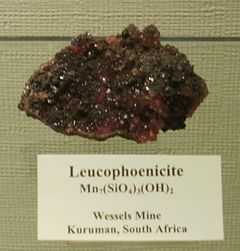Leucophoenicite
| Leucophoenicite | |
|---|---|
 Leucophoenicite from the Wessels Mine in Kuruman, South Africa. | |
| General | |
| Category | Nesosilicates[1] |
| Formula (repeating unit) | Mn7(SiO4)3(OH)2 |
| Strunz classification | 9.AF.60[1] |
| Dana classification | 52.3.2c.2[1] |
| Crystal symmetry |
Space group: P21/a Point group: 2/m |
| Unit cell |
a = 10.84Å b = 4.82Å c = 11.32Å β = 103.93°[1] |
| Identification | |
| Crystal system | Monoclinic |
| Cleavage | Imperfect on {001} |
| Tenacity | Brittle |
| Mohs scale hardness | 5.5 to 6 |
| Luster | Vitreous |
| Diaphaneity | Transparent to translucent |
| Optical properties | Biaxial (-) |
| Refractive index |
nα = 1.751 nβ = 1.771 nγ = 1.782[1] |
| Birefringence | δ = 0.031[1] |
| Pleochroism |
Faint; rose-red ∥ {001} Colorless ⊥ {001} |
| 2V angle | 74° (measured) |
| Ultraviolet fluorescence | Non-fluorescent[2] |
| References | [3] |
Leucophoenicite is a mineral with formula Mn7(SiO4)3(OH)2. Generally brown to red or pink in color, the mineral gets its name from the Greek words meaning "pale purple-red". Leucophoenicite was discovered in the U.S. State of New Jersey and identified as a new mineral in 1899.
Description
Leucophoenicite is normally brown, light purple-red, raspberry-red or pink in color; in thin section it is rose-red to colorless.[3] The name is derived from the Greek words leukos, meaning "pale", and foinis, meaning "purple-red", in reference to its common coloring.[1][2]
Leucophoenicite typically occurs as isolated grains or it has granular massive habit. Crystals of the mineral, which occur rarely, are slender, prismatic, elongated, and striated.[3] The mineral forms in a low pressure, hydrothermal environment or in a contact zone in the veins and skarns of a stratiform Zn-Mn ore body.[3][4]
Leucophoenicite is a member of the humite group.[1] It has been found in association with barite, barysilite, calcite, copper, franklinite, garnet, glaucochroite, hausmannite, jerrygibbsite, manganosite, pyrochroite, rhodochrosite, sonolite, spessartine, sussexite, tephroite, vesuvianite, willemite, and zincite.[3]
History
Leucophoenicite was first found by J. J. McGovern at the Franklin Mine in New Jersey. The specimen, which consisted mostly of the mineral, was given to C. H. Warren in 1897. First thought to be clinohedrite deeply colored by manganese, it was identified as a new mineral in 1899 by Warren and Samuel Lewis Penfield.[5] The mineral was also discovered around this time from the Buckwheat Pit in New Jersey;[1] however, it was not identified as leucophoenicite until 1906 as it had been overlooked or mistaken for some other substance.[6]
The crystallography was first described by Charles Palache in 1910, as Penfield and Warren had been unable to determine even the crystal system of leucophoenicite.[5][7] Material thought to be leucophoenicite, studied in 1928, 1935, and 1967, was in fact a composite of leucophoenicite, sonolite, and alleghanyite.[8] The specimens studied by Warren and Penfield in 1899 and Palache in 1910 were both true leucophoenicite.[9]
Distribution
As of 2012, leucophoenicite has been found in Italy, Japan, Namibia, Romania, South Africa, Sweden, and the US.[1] The type material is held in the United States at Yale University and Harvard University.[3]
References
- ↑ 1.0 1.1 1.2 1.3 1.4 1.5 1.6 1.7 1.8 1.9 "Leucophoenicite". Mindat. Retrieved July 3, 2012.
- ↑ 2.0 2.1 "Leucophoenicite". Webmineral. Retrieved July 3, 2012.
- ↑ 3.0 3.1 3.2 3.3 3.4 3.5 "Leucophoenicite" (PDF). Handbook of Mineralogy. Mineral Data Publishing. Retrieved July 3, 2012.
- ↑ Welch et al. 2002, p. 155.
- ↑ 5.0 5.1 Penfield & Warren 1899, p. 351.
- ↑ Palache 1935, p. 104.
- ↑ Palache 1935, p. 103.
- ↑ Cook 1969, p. 1392.
- ↑ Cook 1969, pp. 1392–93.
Bibliography
- Cook, David (September–October 1969). "Sonolite, Alleghanyite and Leucophoenicite from New Jersey". American Mineralogist 54 (9 & 10): 1392–1398.
- Palache, Charles (1935). The minerals of Franklin and Sterling Hill, Sussex County, New Jersey. US Government Printing Office. pp. 103–105.
- Penfield, Samuel Lewis; Warren, C. H. (November 1899). "Some new minerals from the zinc mines at Franklin, New Jersey, and note concerning the chemical composition of ganomalite". American Journal of Science. 4 8 (47): 339–353. doi:10.2475/ajs.s4-8.47.339.
- Welch, Mark D.; Marhsall, William G.; Ross, Nancy L.; Knight, Kevin S. (January 2002). "H positions in leucophoenicite, Mn7Si3O12 (OH)2: A close relative of the hydrous B phases". American Mineralogist 87: 154–159.
Further reading
- White, T. J.; Hyde, B. G. (February 1983). "A description of the leucophoenicite family of structures and its relation to the humite family". Acta Crystallographica, Section B 39 (1): 10–17. doi:10.1107/S0108768183001950. (subscription required)
- Yau, Yu-Chyi; Peacor, Donald R. (July–August 1986). "Jerrygibbsite-leucophoenicite mixed layering and general relations between the humite and leucophoenicite families". American Mineralogist 71 (7 & 8): 985–988.
External links
| Wikimedia Commons has media related to Leucophoenicite. |
- Photos of leucophoenicite from mindat.org